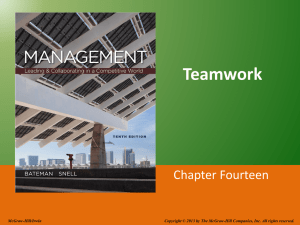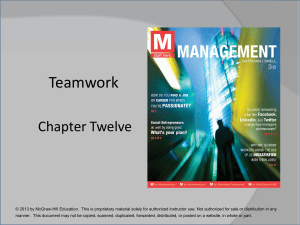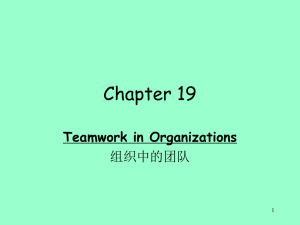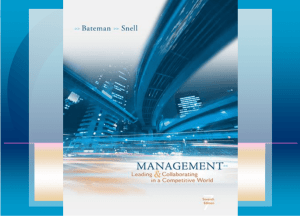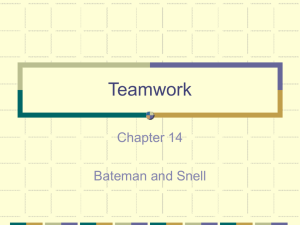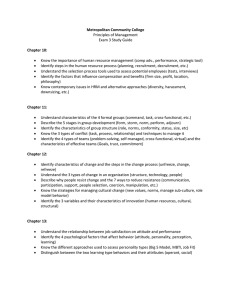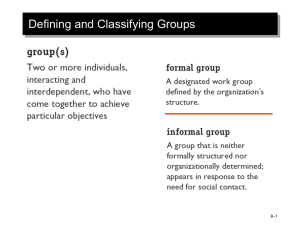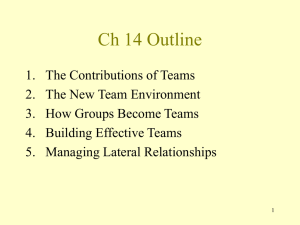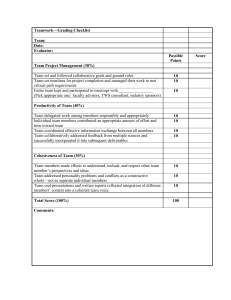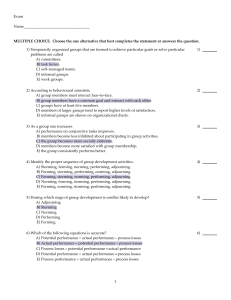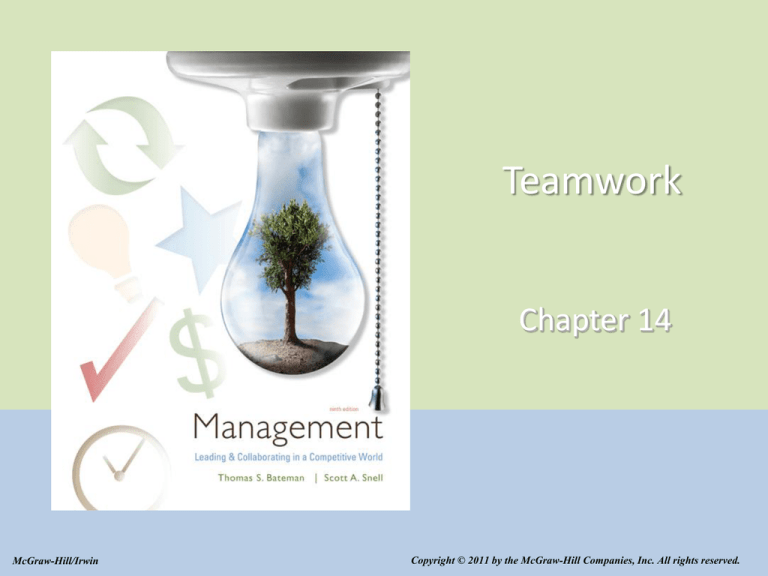
Teamwork
Chapter 14
McGraw-Hill/Irwin
Copyright © 2011 by the McGraw-Hill Companies, Inc. All rights reserved.
Learning Objectives
LO 1 Discuss how teams can contribute to an organization’s
effectiveness
LO 2 Distinguish the new team environment from that of
traditional work groups
LO 3 Summarize how groups become teams
LO 4 Explain why groups sometimes fail
LO 5 Describe how to build an effective team
LO 6 List methods for managing a team’s relationships with
other teams
LO 7 Identify ways to manage conflict
14-2
The Contributions of Teams
Building blocks for organizational structure
Increase quality and productivity while
reducing costs
Enhance speed and be powerful forces for
innovation and change
14-3
The New Team Environment
Team
A small number of people with complementary
skills who are committed to a common purpose,
set of performance goals, and approach for which
they hold themselves
mutually accountable.
14-4
The New Team Environment
Table 14.1
14-5
Types of Teams
Work teams
Teams that make or do
things like
manufacture,
assemble, sell, or
provide service.
Project and
development teams
Teams that work on
long term projects but
disband once the work
is completed.
14-6
Types of Teams
Parallel teams
Teams that operate
separately from the
regular work structure,
and exist temporarily.
14-7
Types of Teams
Management teams
Teams that coordinate and provide direction to
the subunits under their jurisdiction and integrate
work among subunits.
14-8
Types of Teams
Transnational teams
Work groups
composed of
multinational
members whose
activities span multiple
countries.
Virtual teams
Teams that are
physically dispersed
and communicate
electronically more
than face-to-face.
14-9
Practices of
Effective
Virtual
Team
Leaders
Table 14.2
14-10
Self-Managed Teams
Self-managed teams
Autonomous work groups in which workers are
trained to do all or most of the jobs in a unit, have
no immediate supervisor, and make decisions
previously made by frontline supervisors.
14-11
Self-Managed Teams
Traditional work groups
Groups that have no managerial responsibilities.
Quality circles
Voluntary groups of people drawn from various
production teams who make suggestions about
quality.
14-12
Self-Managed Teams
Semiautonomous work groups
Groups that make decisions about managing and
carrying out major production activities but get
outside support for quality control and
maintenance.
Autonomous work groups
Groups that control decisions about and execution
of a complete range of tasks.
14-13
Team Autonomy Continuum
Figure 14.1
14-14
Group Activities
Forming
group members
attempt to lay the
ground rules for what
types of behavior are
acceptable.
Storming
hostilities and conflict
arise, and people
jockey for positions of
power and status.
14-15
Group Activities
Norming
group members agree
on their shared goals,
and norms and closer
relationships develop.
Performing
the group channels its
energies into
performing its tasks.
14-16
Group Activities
Groups that deteriorate move to a declining
stage, and temporary groups add an
adjourning or terminating stage.
Groups terminate when they complete their
task or when they disband due to failure or
loss of interest
14-17
Stepping up
to Team
Leadership
Figure 14.2
14-18
Building Effective Teams
Team effectiveness is defined by three criteria:
Productive output of the team meets or exceeds
standards of quantity and quality
Team members realize satisfaction of their personal
needs
Team members remain committed to working
together again
14-19
Motivating Teamwork
Social loafing
Working less hard and
being less productive
when in a group.
14-20
Motivating Teamwork
Social facilitation effect
Working harder when in a group than when
working alone.
14-21
Question
___________ are shared beliefs about how
people should think and behave.
A. Roles
B. Norms
C. Expectations
D. Customs
14-22
Norms and Roles
Norms
Shared beliefs about
how people should
think and behave.
Roles
Different sets of
expectations for how
different individuals
should behave.
14-23
Roles
Task specialist
An individual who has
more advanced jobrelated skills and
abilities than other
group members
possess.
Team maintenance
specialist
Individual who
develops and
maintains team
harmony.
14-24
Cohesiveness
Cohesiveness
The degree to which a group is attractive to its
members, members are motivated to remain in
the group, and members influence one another.
14-25
Cohesiveness, Performance Norms, and
Group Performance
Figure 14.3
14-26
Building Cohesiveness and HighPerformance Norms
1. Recruit members with similar attitudes, values, and
backgrounds
2. Maintain high entrance and socialization standards
3. Keep the team small
4. Help the team succeed, and publicize its successes
5. Be a participative leader
6. Present a challenge from outside the team.
7. Tie rewards to team performance
14-27
Managing Outward
Gatekeeper
A team member who
keeps abreast of
current developments
and provides the team
with relevant
information.
14-28
Managing Outward
Informing
A team strategy that entails making decisions with
the team and then informing outsiders of its
intentions.
Parading
A team strategy that entails simultaneously
emphasizing internal team building and achieving
external visibility.
14-29
Managing Outward
Probing
A team strategy that
requires team
members to interact
frequently with
outsiders, diagnose
their needs, and
experiment with
solutions.
14-30
Lateral Role Relationships
Work-flow relationships
emerge as materials are passed from one group to
another
Service relationships
exist when top management centralizes an activity to
which a large number of other units must gain access
Advisory relationships
created when teams with problems call on centralized
sources of expert knowledge
14-31
Lateral Role Relationships (cont.)
Audit relationships
develop when people not directly in the chain of
command evaluate the methods and performances of
other teams
Stabilization relationships
involve auditing before the fact
Liaison relationships
involve intermediaries between teams
14-32
Question
Which style of conflict involves moderate
attention to both parties’ concerns.
A.
B.
C.
D.
E.
Avoidance
Accommodation
Compromise
Competing
Collaboration
14-33
Conflict Styles
Avoidance
A reaction to conflict that involves ignoring the
problem by doing nothing at all, or deemphasizing
the disagreement.
Accommodation
A style of dealing with conflict involving
cooperation on behalf of the other party but not
being assertive about one’s own interests.
14-34
Conflict Styles (cont.)
Compromise
A style of dealing with conflict involving moderate
attention to both parties’ concerns.
Competing
A style of dealing with conflict involving strong
focus on one’s own goals and little or no concern
for the other person’s goals.
14-35
Conflict Styles (cont.)
Collaboration
A style of dealing with conflict emphasizing both
cooperation and assertiveness to maximize both
parties’ satisfaction.
14-36
Conflict Management Strategies
Figure 14.4
14-37
Managing Conflict
Superordinate goals
Higher-level goals taking priority over specific
individual or group goals.
14-38
Being a Mediator
Mediator
A third party who
intervenes to help
others manage their
conflict.
14-39
Destination CEO: John Deere
What conflict style did Provide examples of
Bob Lane use when
how Bob Lane has
dealing with the
helped Deere regain
union?
profitability.
14-40

